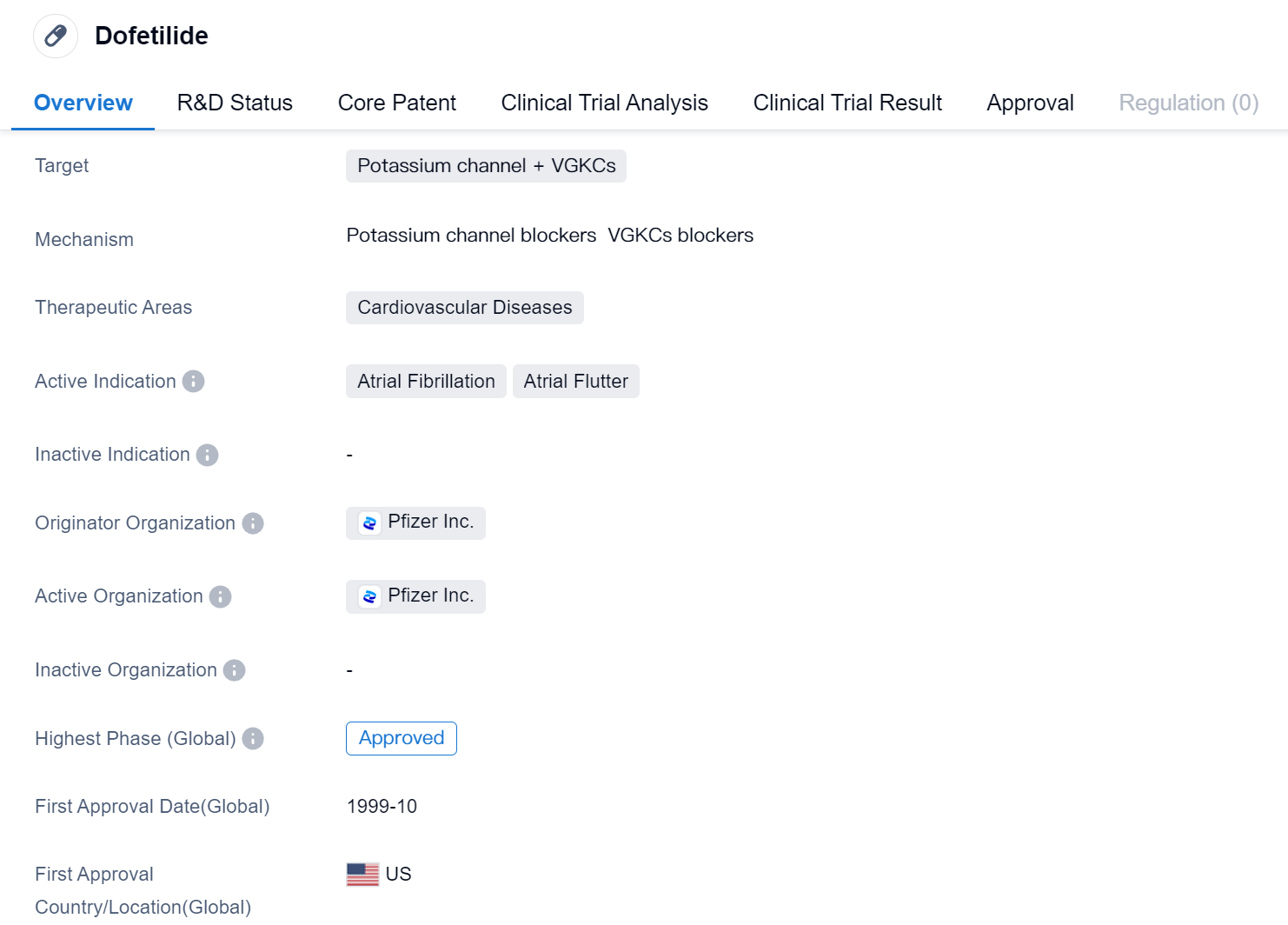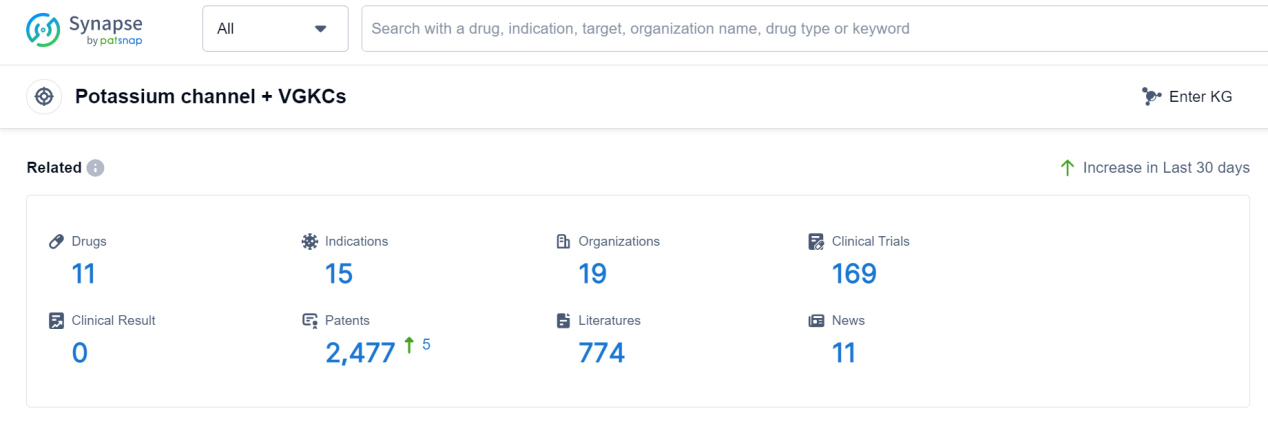Deep Scientific Insights on Dofetilide's R&D Progress
Dofetilide's R&D Progress
Dofetilide is a small molecule drug that falls under the therapeutic area of cardiovascular diseases. It specifically targets the potassium channel and VGKCs (voltage-gated potassium channels). The drug is primarily indicated for the treatment of atrial fibrillation and atrial flutter.
Dofetilide was developed by Pfizer Inc., a renowned pharmaceutical company. It received its first approval in the United States in October 1999, making it available for that country. This approval marked the highest phase achieved by the drug, indicating that it has successfully completed the necessary clinical trials.
Atrial fibrillation and atrial flutter are both common types of irregular heart rhythms that can significantly impact a patient's quality of life and increase the risk of stroke and other cardiovascular complications. Dofetilide works by blocking certain potassium channels in the heart, which helps to restore and maintain a normal heart rhythm.
As a small molecule drug, Dofetilide is likely to have a relatively small molecular size, allowing it to easily penetrate cell membranes and interact with its target proteins. This characteristic may contribute to its effectiveness in treating atrial fibrillation and atrial flutter.
Since its approval in 1999, Dofetilide has been used as a therapeutic option for patients suffering from these specific cardiovascular conditions. It is important to note that the information provided does not include any data on the drug's market performance, sales figures, or any potential side effects or contraindications associated with its use.
👇Please click on the image below to directly access the latest data (R&D Status | Core Patent | Clinical Trial | Approval status in Global countries) of this drug.
Mechanism of Action for Dofetilide: Potassium channel blockers VGKCs blockers
Potassium channel blockers, also known as VGKCs (Voltage-Gated Potassium Channels) blockers, are a class of medications that inhibit or block the activity of potassium channels in the body. Potassium channels are membrane proteins that play a crucial role in regulating the flow of potassium ions across cell membranes. By blocking these channels, potassium channel blockers reduce the efflux of potassium ions, leading to various physiological effects.
From a biomedical perspective, potassium channel blockers are primarily used in the treatment of cardiovascular conditions such as arrhythmias (abnormal heart rhythms) and hypertension (high blood pressure). By inhibiting potassium channels in cardiac cells, these drugs can prolong the duration of action potentials and delay repolarization, thereby stabilizing the heart's electrical activity. This can help prevent abnormal heart rhythms and improve overall cardiac function.
In addition to their cardiovascular applications, potassium channel blockers have also shown therapeutic potential in other areas of medicine. For example, they may be used to treat certain types of epilepsy by reducing neuronal excitability. Furthermore, research suggests that these blockers may have neuroprotective effects and could be investigated for the treatment of neurodegenerative disorders such as Alzheimer's disease.
It's important to note that there are different types of potassium channels in the body, and potassium channel blockers can selectively target specific subtypes. This selectivity allows for more precise therapeutic interventions and reduces the risk of unwanted side effects. Some examples of potassium channel blockers include amiodarone, dofetilide, and sotalol, which are commonly used in the management of cardiac arrhythmias.
Overall, potassium channel blockers, or VGKCs blockers, are medications that inhibit potassium channels in the body, primarily used in the treatment of cardiovascular conditions. They help regulate the electrical activity of the heart and may have potential applications in other areas of medicine as well.
Drug Target R&D Trends for Dofetilide
Potassium channels, specifically Voltage-Gated Potassium Channels (VGKCs), play a crucial role in the human body. These channels are responsible for regulating the flow of potassium ions across cell membranes, thereby controlling various physiological processes. VGKCs are found in excitable cells like neurons and muscle cells, where they contribute to the generation and propagation of electrical signals. They are involved in maintaining the resting membrane potential, controlling action potential duration, and modulating neurotransmitter release. Dysregulation of VGKCs has been associated with various neurological disorders, including epilepsy and movement disorders. Understanding the role of VGKCs is essential for developing targeted therapies and improving patient outcomes in the pharmaceutical industry.
According to Patsnap Synapse, as of 7 Sep 2023, there are a total of 11 Potassium channel + VGKCs drugs worldwide, from 19 organizations, covering 15 indications, and conducting 169 clinical trials.
👇Please click on the picture link below for free registration or log in directly if you have a freemium account, you can browse the latest research progress on drugs, indications, organizations, clinical trials, clinical results, and drug patents related to this target
Conclusion
In summary, Dofetilide is a small molecule drug developed by Pfizer Inc. for the treatment of atrial fibrillation and atrial flutter. It targets the potassium channel and VGKCs and received its first approval in the United States in October 1999. As an approved drug, it has successfully completed clinical trials and met regulatory requirements. However, further information is needed to fully evaluate its market performance and potential impact on patients.






